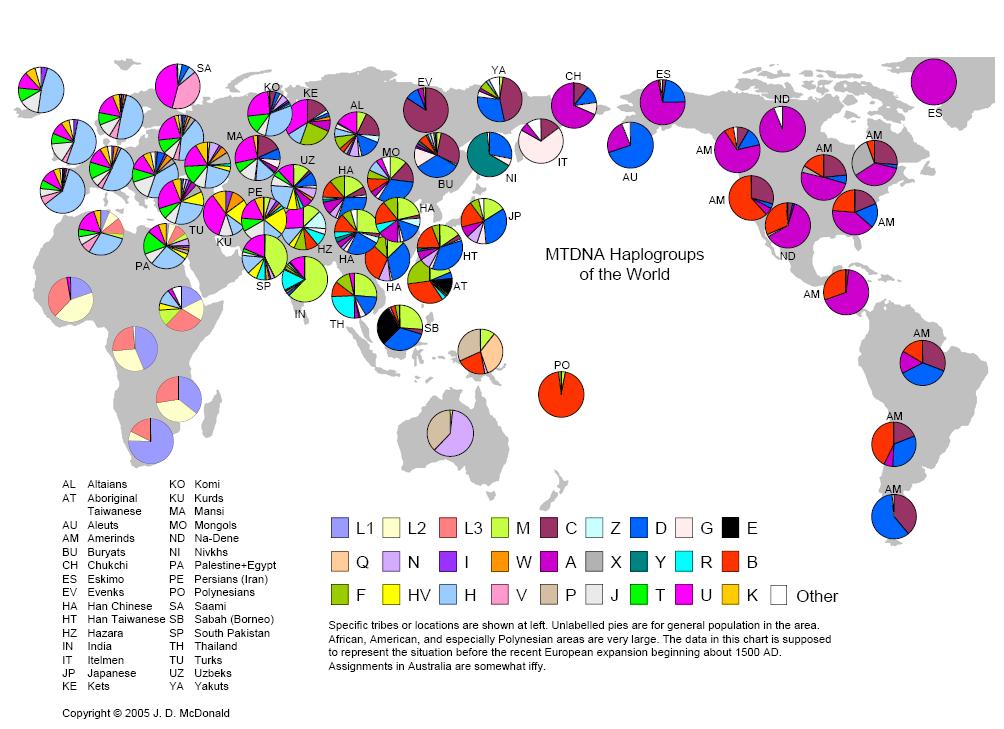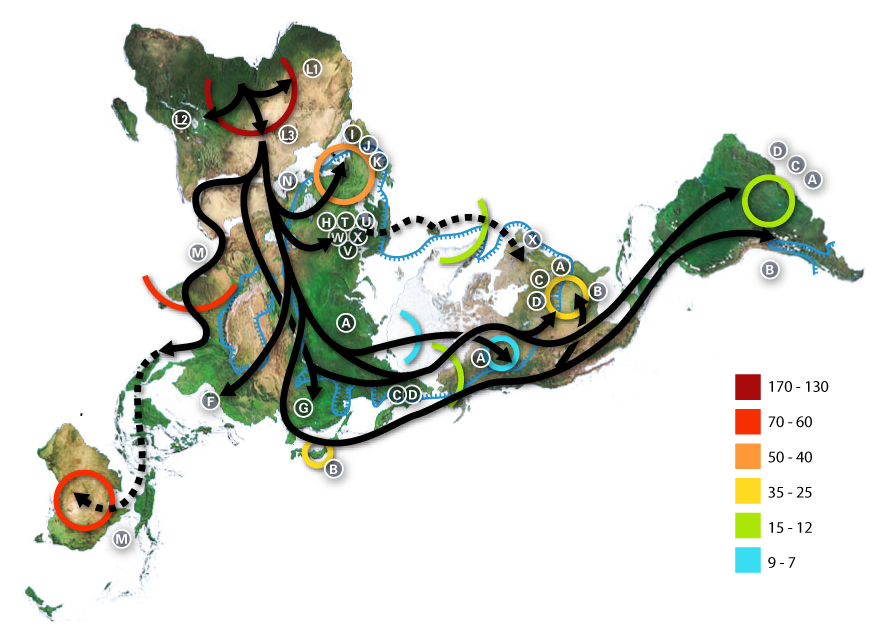
| MadSci Network: Genetics |
Hi Mayra,
Thanks for coming to us for answers to what seems like a deeply personal question. I've taken a little longer than usual to write your answer, so I hope that you find the answer satisfactory, even if it might surprise you.
So, human prehistory is a fascinating and mysterious period of time about which we learn a little bit more each day. Recent human history extends back in time between six to ten-thousand years, and much of the earliest events from this period are remembered today only as myths and legends, but our species is many many times older than what we can remember (as a species) of our time on Earth.
For example, the oldest fossil remains of people who look like modern humans (we call these anatomically modern fossils) are 160,000 years old, and there is evidence (summarized in a previous answer of mine) that these remains were treated with reverence, which suggests that people who appeared human 160,000 years ago were also acting human. So, it seems like human prehistory could be sixteen to twenty-five times longer than what we can recall as human history.
During much of that time, people were exploring the planet, looking for new places to live. We know this, because they usually left quite a lot of stuff behind whereever they went. I’ve summarized the timing of the spread of people across the world in another answer in our archives. In that answer, you can see that our ancestors began to migrate out of Africa about 100,000 years ago, and that the major habitable continental regions had been discovered by our ancestors more than 10,000 years ago. So, that leaves 90,000 mysterious and fascinating years in which the ancestors of modern populations in Africa, Eurasia, Australia, and the Americas were moving around. We know very little about who was doing what and where during that time.
All this is my way of giving you some background context for your question, which asks about genetic evidence of a close relationship between the Saami, who traditionally inhabited the northern reaches of Scandinavia, and the Inuit, who inhabit the arctic regions of the Greenland, North America and Siberia, as indicated by mitochondrial haplogroups. We already have answers in our archives about the uses of mitochondrial DNA for inferring one’s ancestry and a population's history ( 959811537.Ge, 953616676.Cb, and 1038846430.Ge), so I won’t go into great detail about that.
The quick answer to your question comes from a nice pair of summary figures, one of which you can find at http://www.scs.uiuc.edu/~mcdonald/WorldHaplogroupsMaps.pdf (below).

This PDF assembled by JD McDonald describes the major mitochondrial and Y- chromosome haplogroups in a sampling of indigenous populations from around the world, including the Saami (SA) and eastern and western Inuit- related (labeled ES for Eskimo, or AU for Aleut) populations. In the figure above, the mitochondrial haplogroup diversity in a given population is shown as a “pie chart”, where the size of each different colored “slice” of the pie is proportional to the frequency of the corresponding haplogroup.
The second figure summarizes inferred mitochondiral DNA migration patterns, and is from the wikipedia ( en.wikipedia.org/w/index.php?title=Image:Map-of-human-migrations.jpg (below).

This is a view of the continents from above the north pole; it sometimes takes a little mental adjustment to recognize the land masses. Here, the major haplogroups seen in each region are connected by arrows that postulate the migrations of ancient populations, who carried those genes across the world, and the diversification of the haplogroups over human history.
In these figures, you can see that the indigenous peoples of Arctic North America are similar to other indigenous American populations in that they display reduced mitochondrial diversity relative to other populations of the world. In general, mitochondrial haplogroups A, B, C, D, and X are the predominant haplogroups seen in indigenous American populations, and in particular, the eastern Eskimo population is 100% haplogroup A, while the western population’s haplogroups are primarily A and D.
Looking at the Saami, you can see that they resemble other European populations to a certain extent. Mitochondrial haplotypes U (in particular, U5b) and V constitute ~90% of Saami mitochondrial diversity; these haplogroups are seen at lower frequencies in other European populations, and are thought to have originated in western Europe. For example, Haplogroup V is also seen in the Basque people, which has lead many people to conclude that the Saami and Basques perhaps represent the descendants of very ancient inhabitants of Europe. After U and V, the next most frequent Saami haplogroup is H, at about 4%, which is common in Europe as well. However, you will notice a small fraction of the Saami “pie” that represents haplogroup D, and about 5% of the Saami haplogroup diversity is haplogroups D (D5) and Z, both of which are seen in Asian populations.
I wouldn’t take the presence of the D5 haplogroup in the Saami as a sign of a recent connection between the Saami and Inuit populations though, as you can see that haplogroup D is quite common in central and eastern Asia, so that it seems most likely that a small fraction of the ancestors of the Saami came from central Asia, just as most of the ancestors of the Inuit likely did. In addition, the particular haplogroup D5 variants seen in the Saami are particular to Europe, which makes the connection between Europe and Asia via haplogroup D quite ancient. Since mitochondrial DNA is maternally inherited, this all suggests that most of the maternal ancestors of the modern Saami are European.
I’d like to leave you considering the mystery of haplogroup X, which is seen both in indigenous American populations and in some European populations. Unlike most of the other haplogroups, it isn’t clear where people carrying this haplogroup came from. It is possible that as with haplogroup D, they could have originated in central Asia, with some moving east and some moving west, but unlike haplogroup D, they would have to have left no trace of their genes behind in this scenario, which seems unlikely. In addition, the European and American versions of this haplogroup are quite distinct, so that it is clear the introduction of haplogroup X to the Americas vastly pre-dates recent European arrivals to those continents (just as the European D5 haplogroup is quite distinct from Asian D5 haplogroups). What this says to me is that whatever historical genetic connection there may be between Europe and the Americans is quite ancient, and that it dates from that mysterious period of time 10,000 to 50,000 years ago, when many distinct groups of humans were exploring Eurasia, looking for new places to live.
Here are some papers that get into the real “nitty-gritty” of this discussion. I’ve only done a broad review of the issues that pertain to your question; these should really help you with specific questions about the nature of these haplogroups.
Saami mitochondrial and Y-chromosome Haplogroups
Tambets K, Rootsi S, Kivisild T, Help H, Serk P, Loogvali EL, Tolk HV,
Reidla M, Metspalu E, Pliss L, Balanovsky O, Pshenichnov A, Balanovska E,
Gubina M, Zhadanov S, Osipova L, Damba L, Voevoda M, Kutuev I, Bermisheva
M, Khusnutdinova E, Gusar V, Grechanina E, Parik J, Pennarun E, Richard
C, Chaventre A, Moisan JP, Barac L, Pericic M, Rudan P, Terzic R,
Mikerezi I, Krumina A, Baumanis V, Koziel S, Rickards O, De Stefano GF,
Anagnou N, Pappa KI, Michalodimitrakis E, Ferak V, Furedi S, Komel R,
Beckman L, Villems R. (2004) The western and eastern roots of the Saami--
the story of genetic "outliers" told by mitochondrial DNA and Y
chromosomes. Am J Hum Genet. 74:661-82
Richards, M., Macaulay, V., Hickey, E., Vega, E., Sykes, B., Guida,V., Rengo, C., Sellitto, D., Cruciani, F., Kivisild, T., Villems, R., Thomas, M., Rychkov, S., Rychkov, O., Rychkov, Y., Gölge, M., Dimitrov, D., Hill, E., Bradley, D., Romano, V., Calì, F., Vona, G., Demaine, A., Papiha, S., Triantaphyllidis, C., Stefanescu, G., Hatina, J., Belledi, M., Di Rienzo, A., Novelletto, A., Oppenheim, A., Nørby, S., Santachiara-Benerecetti, S., Scozzari, R., Torroni, A., Bandelt, H.-J. (2000). Tracing European founder lineages in the Near Eastern mtDNA pool. American Journal of Human Genetics, 67, 1251-1276.
Mitochondrial haplogroup X
Brown MD, Hosseini SH, Torroni A, Bandelt HJ, Allen JC, Schurr TG, Scozzari R,
Cruciani F, Wallace DC. (1988) mtDNA Haplogroup X: An Ancient Link between
Europe/Western Asia and North America?, American Journal of Human
Genetics, 63:1852-1861
Inuit mitochondrial haplogroup diversity
Malhi RS, Breece KE, Shook BA, Kaestle FA, Chatters JC, Hackenberger S,
Smith DG. (2004) Patterns of mtDNA diversity in northwestern North
America. Hum Biol. 76:33-54. Review.
Rubicz R, Schurr TG, Babb PL, Crawford MH. (2003) Mitochondrial DNA variation and the origins of the Aleuts. Hum Biol. 75:809-35.
Starikovskaya YB, Sukernik RI, Schurr TG, Kogelnik AM, Wallace DC. (1998) mtDNA diversity in Chukchi and Siberian Eskimos: implications for the genetic history of Ancient Beringia and the peopling of the New World.Am J Hum Genet. 63:1473-91.
Torroni A, Sukernik RI, Schurr TG, Starikorskaya YB, Cabell MF, Crawford MH, Comuzzie AG, Wallace DC. (1993) mtDNA variation of aboriginal Siberians reveals distinct genetic affinities with Native Americans. Am J Hum Genet. 53:591-608.
Try the links in the MadSci Library for more information on Genetics.